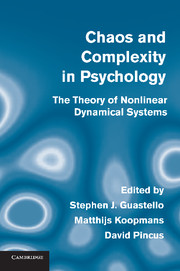Book contents
- Frontmatter
- Contents
- Contributors
- Preface
- 1 Introduction to Nonlinear Dynamics and Complexity
- 2 Collective Intelligence: Observations and Models
- 3 Neurodynamics and Electrocortical Activity
- 4 Psychophysics
- 5 Temporal and Spatial Patterns in Perceptual Behavior: Implications for Dynamical Structure
- 6 Embodied and Embedded: The Dynamics of Extracting Perceptual Visual Invariants
- 7 Origins of Order in Cognitive Activity
- 8 Nonlinear Complex Dynamical Systems in Developmental Psychology
- 9 Developmental Psychopathology: Maladaptive and Adaptive Attractors in Children's Close Relationships
- 10 Psychopathology
- 11 Coherence, Complexity, and Information Flow: Self-Organizing Processes in Psychotherapy
- 12 The Dynamics of Human Experience: Fundamentals of Dynamical Social Psychology
- 13 Group Dynamics: Adaptation, Coordination, and the Emergence of Leaders
- 14 Organizational Psychology
- 15 Complexity, Evolution, and Organizational Behavior
- 16 Agent-Based Modeling Within a Dynamic Network
- 17 Epilogue: Psychology at the Edge of Chaos
- Index
16 - Agent-Based Modeling Within a Dynamic Network
Published online by Cambridge University Press: 18 December 2013
- Frontmatter
- Contents
- Contributors
- Preface
- 1 Introduction to Nonlinear Dynamics and Complexity
- 2 Collective Intelligence: Observations and Models
- 3 Neurodynamics and Electrocortical Activity
- 4 Psychophysics
- 5 Temporal and Spatial Patterns in Perceptual Behavior: Implications for Dynamical Structure
- 6 Embodied and Embedded: The Dynamics of Extracting Perceptual Visual Invariants
- 7 Origins of Order in Cognitive Activity
- 8 Nonlinear Complex Dynamical Systems in Developmental Psychology
- 9 Developmental Psychopathology: Maladaptive and Adaptive Attractors in Children's Close Relationships
- 10 Psychopathology
- 11 Coherence, Complexity, and Information Flow: Self-Organizing Processes in Psychotherapy
- 12 The Dynamics of Human Experience: Fundamentals of Dynamical Social Psychology
- 13 Group Dynamics: Adaptation, Coordination, and the Emergence of Leaders
- 14 Organizational Psychology
- 15 Complexity, Evolution, and Organizational Behavior
- 16 Agent-Based Modeling Within a Dynamic Network
- 17 Epilogue: Psychology at the Edge of Chaos
- Index
Summary
Introduction
The study of nonlinear and complex adaptive systems is well supported by both agent-based modeling (ABM) and dynamic network analysis (DNA) techniques (Carley, 2003; Dooley & Corman, 2002). When applied, separately or jointly, to research design, ABM and DNA are powerful techniques that have recurrently led to the progress of social theory over recent decades. Both have also been technological forces leading to the acceptance of computer simulation as a sound and revolutionary research methodology (Bankes, 2002); a methodology that has come to be heralded as the third way of doing research (Axelrod, 2006; Elliott & Kiel, 2004; Ostrom, 1988). This revolution is being further fueled by the escalating dissatisfaction with traditional research methods (Elliott & Kiel, 2004) and the ubiquity of inexpensive computing power. The growing number of success stories of applying ABM, DNA, and computer simulation to social research is rapidly escalating the broad acceptance of these tools by researchers – as evidenced by numerous supportive, scholarly articles recently published in prominent academic publications (Davis, Eisenhardt, & Bingham, 2007; Harrison, Lin, Carroll, & Carley, 2007; Henrickson, 2004).
The success of these techniques reflect the realization that in human systems the complex behaviors of individuals acting within a group are not only critical to the microlevel dynamics, but that the stability, adaptability, and evolution of the entire system can be heavily influenced by these behaviors.
- Type
- Chapter
- Information
- Chaos and Complexity in PsychologyThe Theory of Nonlinear Dynamical Systems, pp. 475 - 505Publisher: Cambridge University PressPrint publication year: 2008
- 1
- Cited by



